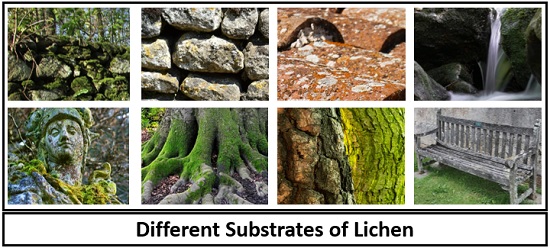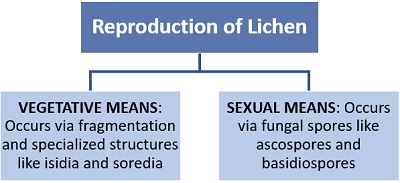Lichens are complex organisms that show a mutualistic relationship between fungi and algae by possessing characteristics of both. They show polymorphism by existing in diversified forms (sometimes plant-like) with different colours, sizes, and textures. Lichens represent the close association or symbiotic association of fungi with few algae and cyanobacteria.
Lichens are not plants, but at times they appear as tiny leafless branches or flat leaf-like structures. In addition, they also form organic food by their own through photosynthesis, like plants. Macro and micro-lichens are the two common forms. They grow in a variety of substrates like soil, wood, concrete etc.
Unlike plants, lichens lack a root system for water and nutrient absorption. It constitutes about 6% of Earth’s land surface. It is estimated that lichens account for nearly 17,000 to 20,000 species, which are known so far.
Content: Lichens
Meaning of Lichen
Lichens are bizarre organisms that show a mutualistic relationship between dominant partner mycobionts (like fungi) and phycobionts like algae and cyanobacteria. Ascomycetes and basidiomycetes fungi are the dominant partners that give lichens the majority of their characteristics like thallus organization and fruiting bodies. Green algae or cyanobacteria (blue-green algae) are the secondary partners to which fungi associate symbiotically.
The term lichen was introduced by a scientist named Theophrastus. Lichens are ubiquitous, found in a variety of habitats. The examination of lichen’s macroscopic and microscopic characters (such as reproductive structures, spores and cellular features) can be studied via chemical tests and chromatographic methods.
Growth Pattern
Habitat: Lichen generally lives in humid and exposed conditions. But, they can also thrive in extreme desiccation. They cannot tolerate extreme air pollution because of sulphur dioxide presence. The growth pattern of lichen is slow but perennial (some may remain alive for thousands of years).
Substrate: Lichens develop on different substrates like:

- Bark of tree
- Leaves of higher plants
- Mosses
- Living as epiphytes in temperate woodland.
- Solid surfaces like rock outcrops, walls, roofs etc.
- In the soil as part of a biological soil crust.
Structure
The anatomy of lichens reveals that their internal morphology is almost the same in all species.
- The outer surface of lichen contains fungal filaments that are rigorously packed together, constituting the cortex, and protecting the algal cells from heat.
- Below the dense layer of fungal filaments, a layer of algal cells generally exist. The algal cells do not possess a firm arrangement or not so dense to permit the gaseous exchange between the cells and the environment. It aids in the photosynthetic activity that forms an organic food for lichens.
- The medulla is found below the mass of algal cells. The medulla of crustose and squamulose lichens directly affixes to the suitable substratum. In contrast, the medulla in foliose lichens is followed by a second cortical layer.
Types of Lichens
There are four distinct kinds of lichens.

- Crustose lichen appears as a thin crust firmly appressed over the substrate and markedly two dimensional. It includes Graphis, Caloplaca, Rhizocarpon, Haematoma etc.
- Foliose lichen appears as a flat leaf-like and branched structure. Unlike crustose, the lichen body does not attach firmly to the substrate. It includes members of Parmelia, Peltigera etc.
- Squamulose lichens exist as numerous small rounded lobes that are tightly clustered and slightly flattened pebble-like units. They comprise some scaly patterns or squamules. Squamulose lichen resembles foliose lichen when its body originates from the substrate, appears leaf-like and devoid of the cortex. Sometimes, they also resemble crustose lichens due to their tightly clustered body. Therefore, squamulose lichens form a connecting link between crustose and foliose lichens. They include species like Vahliella leucophaea, Cladonia subcervicornis etc.
- Fruticose lichens appear as an erect branching tube that associates with the substratum via disc. Markedly, they are three-dimensional. Fungi (mycobionts) dominantly constitute the lichen body, whereas algae (phycobionts) constitute only 5%. Its structure generally includes the surface, medulla and rhizines. They include species like Usnea, Evernia etc.
Reproduction of Lichens
The majority of lichens reproduce through vegetative reproduction, but few species reproduce sexually.

Vegetative Methods
Lichens multiply vegetatively by the following ways:
- Fragmentation is a vegetative method in which the lichen body turns into several fragments due to mechanical injury and trampling. Eventually, each fragment grows into new vegetative structures.
- Reproduction by specialized structures:
- Isidia exist as the columnar protrusions that originate from the thallus and carry fungal hyphae and algal cells. They enhance the photosynthetic activity. Isidia break off during unfavourable conditions, after which they turn into new lichens.
- Soredia are microscopic or powdery reproductive structures. They produce in a large number and comprise a hyphal network around the green alga or cyanobacterial cell. They are the propagules present inside the sori or pustules. Soredia form new vegetative bodies once they fall on the suitable substratum via wind transmission.
Sexual Reproduction
Some lichens may also reproduce sexually through different spores or fruiting bodies, as seen in fungi. As we know, most of the members belonging to the family of Ascomycetes (Ascolichens) and Basidiomycetes (Basidiolichens) are the dominant partners of lichens.
Ascomycetes possess apothecia, perithecia and cleistothecia as the reproductive structures, which develop fruiting bodies or ascospores inside a sac called “Asci“.
- Apothecia appear as a small cup-like and open structure that comprise ascospores in the terminal layer or hymenium region above the thallus. The members belonging to the Discomycetes group produce apothecia. An upper (hymenium), middle hypothecium and terminal (excipulum) region are the three structural components of apothecia.
- Perithecia appear as a partially closed, globose and funnel-like structure that contain asci embedded inside the thallus. The members belonging to the Pyrenomycetes group produce perithecia. They have a small pore (ostiole). In perithecium, asci develop from the base and face the ostiole.
- Cleistothecia appear completely enclosed, inside which asci (club-shaped to spherical) are dispersed. The members belonging to the Plectomycetes group form cleistothecia. The cliestothecial wall lyses at maturity, from which the ascospores escape.
Basidiolichens comprise fruiting bodies (basidia) that form reproductive structures or basidiospores.
- Basidia appear palisade-like. A basidium carries four basidiospores at the tips of sterigmata that detach during unfortunate conditions. Therefore, the dispersed spores in the environment fall on suitable alga and a germ tube forms during favourable conditions. The germination tube grows in length and fuses with the wall of the alga, and eventually, a new vegetative body develops.
Economic Importance of Lichens
Lichens have diversified applications:
- Environmental Science: Lichens are macroscopic creatures sensitive to the air pollutants like SO2. Therefore, they serve as a pollution indicator, estimating the concentration of contaminants in the atmosphere.
- Medical Science: Lichen also plays a significant role in medicinal preparations. It releases certain secondary metabolites resistant in counter to bacterial, viral and parasitic infections. Hence, few species of lichen also provides anti-viral and anti-bacterial medications.
- Tanning and Dyeing: Traditionally, the secondary metabolites of lichens were used to dye woollen cloth before the discovery of synthetic dyes. It is produced commercially in litmus paper preparation to check the acidity or basicity of the solutions.
- Cosmetic Industry: Lichens like Evernia, Ramalina etc., produce aromatic substances that aid the production of essential oil, cosmetic products and perfumes.
Conclusion
We can conclude that lichens possess mycobionts or fungal components that provide shelter, water, and nutrition to the algal biomass. In return, the algal cells (green algae or cyanobacteria) undergo photosynthesis and provide organic food to fungi. In this way, lichens show a symbiotic relationship where both the organisms are mutually benefitted.